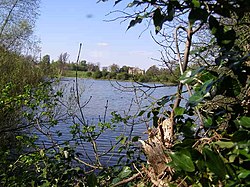Culverthorpe
| Culverthorpe | |
| Lincolnshire | |
|---|---|
 Lakeside at Culverthorpe, overlooked by Culverthorpe Hall | |
| Location | |
| Grid reference: | TF024402 |
| Location: | 52°57’1"N, 0°28’36"W |
| Data | |
| Post town: | Grantham |
| Postcode: | NG32 |
| Dialling code: | 01400 |
| Local Government | |
| Council: | North Kesteven |
| Parliamentary constituency: |
Grantham and Stamford |
Culverthorpe is a hamlet in the ancient parish of Heydour in the Kesteven part of Lincolnshire. It is situated five miles south-west of Sleaford, nine miles north-east of Grantham and three miles south-east of Ancaster. It lies in the wapentake of Aswardhurn, along with neighbouring Kelby, the two having formed the civil parish of Culverthorpe and Kelby since 1931.
History
According to A Dictionary of British Place Names, the 'thorpe' in Culverthorpe derives from the Old Scandinavian for "outlying farmstead or hamlet", with 'Culver' the later added owner's name of uncertain origin.[1]
In the Domesday account of Aswardhurn wapentake, Culverthorpe is written as "Torp". There were nine households, eight villagers, a priest and a church, four ploughlands and 120 acres of meadow. Before the Conquest the lordship was held by Tonni of Lusby but afterwards by Gilbert of Ghent who also became Tenant-in-chief.[2]
The hamlets of Heydour and Culverthorpe passed through various plantagenet owners during the reign of Henry III. The Grade-I-listed Culverthorpe Hall, together with its estate, farm, park and lake, was constructed in 1679 for the Newton family "in the Italian style" with later additions.[3][4][5][6] In the reign of Charles II the house and estate descended to Sir John Newton, 2nd Baronet, MP for Grantham for 25 years, then to his son, another John, and then to his grandson Sir Michael Newton, Bt, appointed Knight of the Order of the Bath in 1725 and also MP for Grantham. On Sir Michael's death in 1743 the estate transferred to his sister, Susanna Archer, and through her to her issue and their siblings, who adopted the Newton name. The last Newton, another Michael, died in 1803, whereupon the house became untenanted.[4][7] In the 20th century the estate transferred to the Dymoke branch of the family.[8]
Culverthorpe is recorded in the 1872 White's Directory as a village and township in the parish of Haydor (Heydour), with a population of 101 in 846 acres of land. Culverthorpe land was owned by J. A. Houblon [John Archer-Houblon (1803-1891)] of Hallingbury Place [demolished 1926, at Great Hallingbury] in Essex. Culverthorpe Hall was unoccupied in 1872, but its owner and lord of the manor derived the house from his grandfather, "the last of the Newtons". The chapel built by the Newtons was disused, and there were "no traces of the ancient chapel, dedicated to St Bartholomew". The principal inhabitants of Culverthorpe in 1872 were three farmers, one of whom was also a carpenter and builder.[9]
The chapel dedicated to St Bartholomew once stood in the hamlet,[7] its pews later being added to the church of St Andrew at Kelby.[10]
References
- ↑ Mills, Anthony David (2003); A Dictionary of British Place Names, Oxford University Press, revised edition (2011), p.143. ISBN 019960908X
- ↑ "Culverthope", Domesdaymap.co.uk. Retrieved 23 December 2011
- ↑ Culverthorpe Hall, parksandgardens.ac.uk. Retrieved 22 June 2011
- ↑ 4.0 4.1 Lord, John “A Chapel and Some Garden Walls: Culverthorpe in the 1690s” Architectural History – Journal of the Society of Architectural Historians of Great Britain Vol. 40, 1997
- ↑ Kelley’s Directory of Lincolnshire with the Port of Hull 1885 p 471
- ↑ National Heritage List 1061793: Culverthorpe Hall, Culverthorpe and Kelby
- ↑ 7.0 7.1 Creasey, James (2010); Sketches, illustrative of the topography and history of New and Old Sleaford, BiblioBazaar, pp. 234-236 ISBN 1-143-93153-X. Retrieved 22 June 2011
- ↑ "Titled Gal Elopes with Groom", TriCity Herald, 8 May 1955. Retrieved 19 May 2012
- ↑ White, William (1872), Whites Directory of Lincolnshire, p.564
- ↑ Cox, J. Charles (1916) Lincolnshire p. 181; Methuen & Co. Ltd
Outside links
| ("Wikimedia Commons" has material about Culverthorpe) |
- Culverthorpe in the Domesday Book